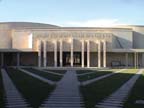
From the beginning, the creators of the project knew that the new Jewish Community Center would be a religious, institutional and cultural center for the Jewish population of Costa Rica's capital city of San Jose and beyond. It was designed according to standards outlined in the Kaballah, and it includes a range of hand-crafted stonework.
“We used Jerusalem Cream and Jerusalem Gold limestone,†the architect explained through an interpreter. “It was used in many finishes - polished, bushhammered, flamed, honed and in its natural cut state.†The material was quarried in Israel by Alony Marble, and all of the stone was supplied through Rocazul, which has branches in Costa Rica, Venezuela and the U.S.
Weisleder said that in addition to being an aesthetically pleasing stone for the project, it also tied the center to its roots in Israel. “It was used on the main facade and in the Aron Hakodesh, the sacred Ark, as an accent to the importance of Jerusalem for the people of the Diaspora [Jewish community outside of Israel].â€
Various areas of the community center feature different varieties of Jerusalem Stone. Jerusalem Cream was used in the entrance building, while Jerusalem Gold was used in the Synagogue.
The principals of the project researched a number of stone materials before making their selection, and in addition to Jerusalem Stone, other stones were used in the design. “Many samples were provided until the perfect match was obtained,†Weisleder said, adding that the design also uses granite from Spain and green marble from Guatemala, as well as quartzite and slate. In all, approximately 80,000 square feet of stone was used for the project.
The architect was particularly pleased with the way the stone materials blend with the overall design of the center. “The rest of the exterior facades were painted, and the colors melt with the stone,†she said. “The interior [stone] is complemented with wood and textured painting.â€
The size of the stone ranges from standard tiles for the floors to larger pieces for the facade and steps. In addition to polished, bushhammered, flamed, honed and natural-cut pieces, the limestone flooring features a brushed finish for all high-traffic areas.
Installing the stone was relatively straightforward, according to the architect. “It was quite simple,†Weisleder said. “The only difficult part was to work with the rough stone used on the towers of the facade because of the height and weight. But we were advised by Rocazul on what kind of product to use in order to place the stones.â€
“The stone was installed on walls and floors with a latex modified mortar, mainly as a thinset, since all [backup] walls were concrete,†explained Jacobo Eisen of Rocazul. “No special fixtures were used, and the latex additives were from a local producer. Rocazul suggested the installation method from its own experience, but also consulted with some [consultants].â€
The general contractor on the project was EDICA Ltda., which specializes in large-scale construction work in Central America. Installation of the stone was completed in conjunction with the overall construction, and it took approximately seven months.